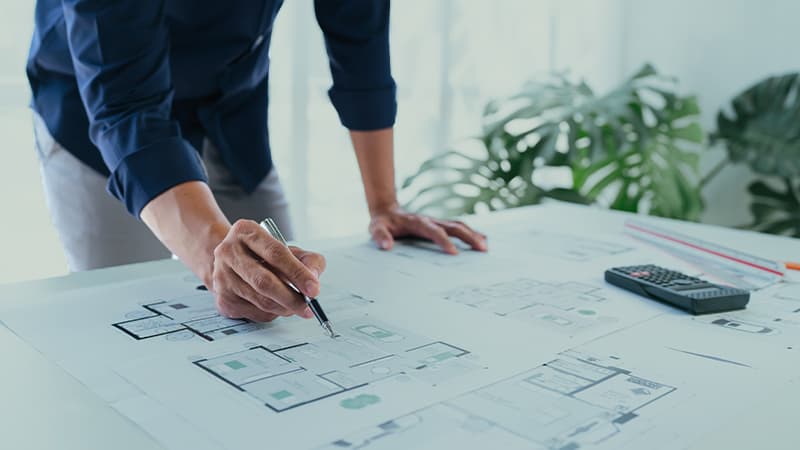Architect-Approved Home Improvement Ideas
Comprehending the Diverse Profession Paths Available for Aspiring Architect
As an aspiring Architect, you have a world of career courses waiting for you. Whether you're attracted to conventional architecture or the nuances of lasting layout, there's a niche that lines up with your passions.
Conventional Design: Creating Structures and Structures
Typical architecture concentrates on making structures and frameworks that blend functionality with aesthetic charm. As you explore this field, you'll value the complex balance between form and purpose. You'll learn to draw motivation from historical designs, incorporating aspects like balance, products, and workmanship. Your designs can reflect social heritage, showcasing neighborhood customs while fulfilling modern-day demands.
You'll create abilities in drafting, model-making, and website evaluation, enabling you to envision and connect your concepts properly. Engaging with customers, you'll need to recognize their vision and equate it into feasible layouts.
Furthermore, building codes and sustainability methods are important in your work, guaranteeing your frameworks are risk-free and eco-friendly. As you expand in your profession, you'll find chances in household, commercial, or even remediation tasks, each offering special obstacles. Embracing standard style leads the way for a meeting job that pays homage to the past while forming the future.
Urban Planning: Shaping Neighborhoods and Public Spaces
As an ambitious Architect, you can play a necessary role as an urban organizer, changing just how communities function and interact. By using neighborhood interaction approaches, you'll ensure that citizens have a voice in shaping their setting. Plus, incorporating sustainable layout principles will assist produce spaces that not just fulfill today's requirements but additionally secure the future.
Duty of Urban Planners
While lots of may assume of engineers as the single enthusiasts behind structures, city coordinators play a necessary duty fit the more comprehensive landscape of neighborhoods and public rooms. They analyze land use, zoning legislations, and neighborhood needs to produce lasting settings that enhance lifestyle. By collaborating with various stakeholders, you'll assist create parks, transport systems, and domestic locations that advertise social communication and accessibility. Urban planners also concentrate on ecological factors to consider, ensuring that developments integrate eco-friendly areas and assistance biodiversity. Your competence in spatial style and neighborhood characteristics permits you to picture future development while maintaining social heritage. In this essential function, you'll directly affect how people experience their surroundings, making every project an opportunity for positive change.
Neighborhood Interaction Strategies
Reliable area engagement techniques are important for city organizers to guarantee that the voices of locals are listened to and valued in the planning process. To cultivate significant discussion, you must focus on open online forums and workshops where area participants can share their concepts and concerns. By actively listening and integrating comments, you'll produce areas that show the neighborhood's requirements, ultimately leading to more sustainable and successful city environments.
Lasting Layout Concepts
When making city spaces, incorporating lasting layout concepts is essential for producing atmospheres that prosper both environmentally and socially. You need to begin by concentrating on power performance, making use of products that lower waste and advertise recycling. Think about incorporating environment-friendly rooms, like yards and parks, to enhance biodiversity and improve air high quality. Advertising walkability and public transport can reduce dependence on vehicles, fostering a much healthier area.
Creating with water conservation in mind is likewise key-- think about rainfall gardens and absorptive surfaces to take care of stormwater. Involving community participants throughout the planning procedure warranties that the rooms you produce fulfill their requirements and urge social interaction. By welcoming these principles, you'll add to dynamic, lasting urban landscapes that benefit every person.

Landscape Style: Producing Sustainable Outdoor Settings
As you check out landscape architecture, you'll find necessary style concepts that produce practical and gorgeous exterior areas. Sustainable methods play a vital duty in guaranteeing these atmospheres grow while decreasing environmental influence. Plus, you'll locate a selection of job chances that permit you to make a genuine distinction in how people interact with nature.
Style Concepts in Landscape
Comprehending layout concepts in landscape architecture is important for developing sustainable outside settings that harmonize with nature. You'll require to contemplate aspects like equilibrium, percentage, and scale to ensure your layouts feel natural and inviting. Integrating indigenous plants not only enhances biodiversity however likewise lowers water use, making your landscape resilient. Consider the flow of area and just how individuals engage with it; paths and seating areas should invite expedition and relaxation. Additionally, focus on seasonal modifications, making with materials that complement the environments year-round (Architect). By focusing on sustainability and appearances, you can develop outside rooms that enhance the community and promote wellness. Welcoming these principles will establish a strong structure for your job in landscape design.
Lasting Practices Summary
Lasting practices in landscape design not only concentrate on visual appeals however additionally prioritize ecological health and wellness and source conservation. You can develop areas that advertise dirt health and wellness, such as making use of organic materials and practicing permaculture concepts. Inevitably, these techniques guarantee your designs benefit both people and the atmosphere for years to come.
Career Opportunities Exploration
With a strong foundation in sustainable methods, landscape design uses a selection of job paths that enable you to make a purposeful influence on the setting. You can function as a landscape developer, developing aesthetically pleasing and practical exterior rooms, or specialize in ecological restoration, helping to revive damaged communities. Urban coordinators often work together with landscape designers to produce eco-friendly areas in urban setups, improving city livability. If you're enthusiastic regarding education and learning, think about ending up being a landscape design teacher, inspiring future generations. In addition, you might work with nonprofits concentrated on ecological sustainability or involve in research to introduce brand-new techniques. Each course not only forms beautiful settings yet likewise cultivates a much healthier planet for future generations.
Lasting Style: Concentrating On Eco-Friendly Practices
As you explore your profession in style, embracing environmentally friendly techniques can set you apart in an affordable field. Lasting layout concentrates on developing buildings that lessen environmental effect while boosting resident health. By incorporating eco-friendly materials, energy-efficient systems, and sustainable structure techniques, you'll add to a greener future.
Begin by acquiring expertise of green qualifications like LEED or BREEAM, which can bolster your credentials. Think about how natural light, air flow, and thermal performance can optimize style. Work together with designers and environmental specialists to introduce remedies that reduce waste and save resources.
Do not fail to remember the relevance of community participation-- interesting neighborhood stakeholders can inspire designs that harmonize with the setting. As clients progressively prioritize sustainability, your proficiency in eco-friendly methods will certainly not only bring in tasks but also satisfy your enthusiasm for liable style. Accept this critical facet of the occupation, and view your occupation grow.
Historic Preservation: Safeguarding and Bring Back Cultural Heritage
While you commence on your building trip, think about the crucial duty of historical preservation in maintaining our social heritage. This area concentrates on the defense and repair of significant buildings, sites, and structures that over at this website tell the stories of our past. By involving in historical preservation, you'll help protect the architectural legacy that forms neighborhood identity.
As a historic conservation Architect, you'll assess historical significance and examine the condition of frameworks. You'll work closely with chroniclers and conservationists to ensure authentic repair techniques are used. This job course permits you to blend creative thinking with research study, allowing you to make options that respect initial products and craftsmanship.
Your job not just adds to sustainability by recycling existing buildings yet additionally cultivates a sense of satisfaction within communities. Welcoming this path will certainly help you become a guardian of history, protecting the tales and visual appeals that improve our lives.
Interior Design: Enhancing Indoor Spaces
Historical preservation and interior style both share a commitment to improving the constructed environment, however they concentrate on different facets. While historic preservation highlights keeping a framework's historical and cultural value, indoor style zeroes in on optimizing indoor rooms for performance and aesthetics.
As an ambitious Architect, you'll discover that indoor architecture allows you to blend imagination with technological abilities. You'll design rooms that not only look good yet likewise promote comfort and effectiveness. This area involves understanding how light, color, and materials communicate within a space, impacting state of mind and functionality.
You'll function on numerous tasks, from property homes to business workplaces, ensuring that each environment meets the needs of its occupants. By focusing on customer experience, you can change insides into inspiring and functional areas, making a substantial effect on exactly how people connect with their environments. Welcome the chance to improve indoor environments and shape the means people live and work.
Industrial Design: Merging Performance With Visual Appeals
Industrial design plays a vital role in creating items that effortlessly mix looks with performance, guaranteeing that what you make use of everyday is not only aesthetically enticing however also sensible. As a hopeful Architect, you might engage yourself in this area, focusing on making whatever from furniture to customer electronics. Your job includes understanding customer needs, products, and producing processes, enabling you to create ingenious solutions that improve daily experiences.
In industrial style, you'll usually work together with makers, engineers, and online marketers, making sure that your styles are not only lovely yet also possible. This career path supplies a vibrant atmosphere where creative thinking fulfills functionality, making it a satisfying choice for architects interested in forming the items of tomorrow.
Often Asked Concerns
What Educational Qualifications Do I Required to End Up Being a Designer?
To become a designer, you'll need a professional level in design, generally a Bachelor's or Master's. Additionally, you'll need to complete an internship and pass the Architect Registration Examination to exercise lawfully.
Are There Accreditation Needs for Various Building Occupation Paths?
Yes, there're certification requirements for different architectural paths. Architect. You'll require to pass examinations, complete internships, and occasionally go after specialized training, relying on your chosen emphasis, like landscape architecture, metropolitan design, or historical preservation
What Software Program Skills Are Essential for Designers Today?

Just How Can I Gain Practical Experience While Researching Style?
You can get practical experience by interning at building firms, participating in design competitions, offering for community tasks, or working together with classmates on real-world assignments. These opportunities boost your abilities and construct important connections in the industry.
What Task Opportunities Exist Outdoors Typical Style Firms?
You can his comment is here check out different task possibilities outside standard style firms, like city planning, interior decoration, landscape design, building and construction administration, realty growth, or even functions in sustainability consulting. Each deals distinct difficulties and incentives.
Whether you're drawn to conventional style or the subtleties of sustainable design, there's a particular niche that aligns with your rate of interests.When developing city rooms, incorporating sustainable style concepts is crucial for developing atmospheres that grow both ecologically and socially.As you discover landscape style, you'll find vital layout concepts that create stunning and useful exterior rooms.Recognizing layout concepts in landscape style is essential for developing lasting outdoor environments that harmonize with nature.In industrial layout, you'll frequently work together with marketers, suppliers, and designers, ensuring that your designs are not just beautiful yet also practical.